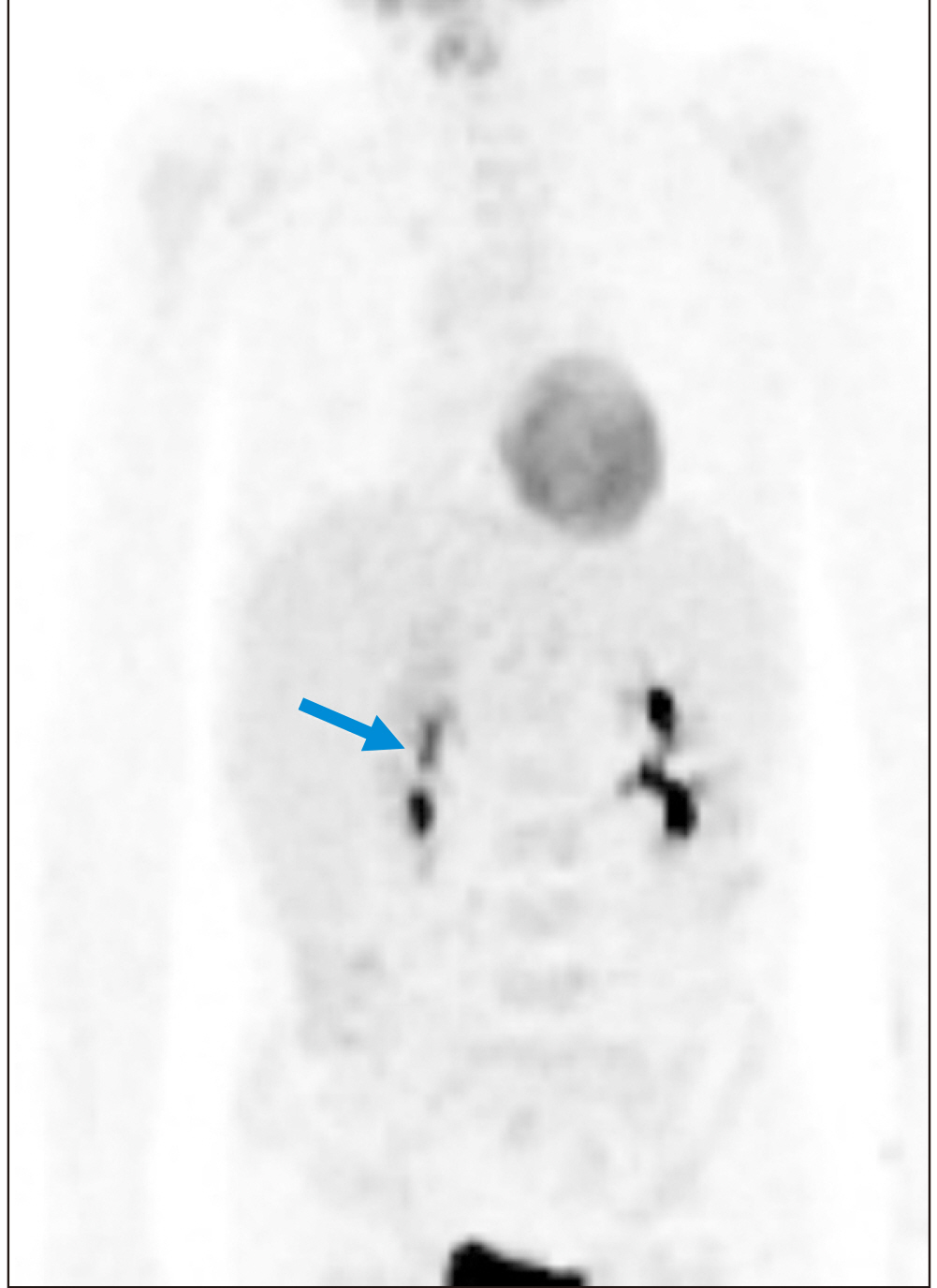Korean J Transplant.
2022 Jun;36(2):148-153. 10.4285/kjt.21.0008.
Pediatric living donor liver transplantation for biliary embryonal rhabdomyosarcoma: a case report of a case showing disease-free survival over 2 years
- Affiliations
-
- 1Division of Pediatric Surgery, Department of Surgery, Asan Medical Center, University of Ulsan College of Medicine, Seoul, Korea
- 2Division of Hepatobiliary Surgery and Liver Transplantation, Department of Surgery, Asan Medical Center, University of Ulsan College of Medicine, Seoul, Korea
- 3Department of Pediatrics, Asan Medical Center, University of Ulsan College of Medicine, Seoul, Korea
- KMID: 2531139
- DOI: http://doi.org/10.4285/kjt.21.0008
Abstract
- Biliary rhabdomyosarcoma is a rare tumor, but it is still the most common tumor of the biliary tract in children. We report a case of a 6-year-old boy with biliary embryonal rhabdomyosarcoma and liver metastasis, which were treated with neoadjuvant and adjuvant chemotherapy combined with living donor liver transplantation (LDLT). Initial imaging studies showed a low-attenuation intraductal mass from the left hepatic duct to the intrapancreatic common bile duct with diffuse upstream dilatation of the intrahepatic duct and liver metastasis. Endoscopic biopsy revealed embryonal rhab- domyosarcoma. After tumor size reduction through neoadjuvant chemotherapy, LDLT was planned to remove the tumor completely. A left lateral section graft weighing 330 g was harvested from his 38-year-old mother and the graft-to-recipient weight ratio was 1.94%. Routine pediatric LDLT operation was performed with deep excavation of intra-pancreatic distal bile duct. The explant liver showed minimal residual embryonal rhabdomyosarcoma with no lymph node metastasis. The patient recovered uneventfully from LDLT operation. Scheduled adjuvant chemotherapy was performed for 6 months. The patient is doing well without any evidence of tumor recurrence for 26 months after LDLT. In conclusion, liver transplantation could be an effective treatment for unresectable biliary rhabdomyosarcoma in children according to the location of tumor.
Figure
Reference
-
1. Liver Cancer Study Group of Japan. 1990; Primary liver cancer in Japan: clinicopathologic features and results of surgical treatment. Ann Surg. 211:277–87.2. Kim HR, Rha SY, Cheon SH, Roh JK, Park YN, Yoo NC. 2009; Clinical features and treatment outcomes of advanced stage primary hepatic angiosarcoma. Ann Oncol. 20:780–7. DOI: 10.1093/annonc/mdn702. PMID: 19179547.3. Mehrabi A, Kashfi A, Fonouni H, Schemmer P, Schmied BM, Hallscheidt P, et al. 2006; Primary malignant hepatic epithelioid hemangioendothelioma: a comprehensive review of the literature with emphasis on the surgical therapy. Cancer. 107:2108–21. DOI: 10.1002/cncr.22225. PMID: 17019735.4. Na BG, Hwang S, Ahn CS, Kim KH, Moon DB, Ha TY, et al. 2021; Prognosis of hepatic epithelioid hemangioendothelioma after living donor liver transplantation. Korean J Transplant. 35:15–23. DOI: 10.4285/kjt.20.0049. PMID: 35769618. PMCID: PMC9235330.5. Chavhan GB, Siddiqui I, Ingley KM, Gupta AA. 2019; Rare malignant liver tumors in children. Pediatr Radiol. 49:1404–21. DOI: 10.1007/s00247-019-04402-8. PMID: 31620842.6. Otte JB, de Ville de Goyet J, Reding R. 2005; Liver transplantation for hepatoblastoma: indications and contraindications in the modern era. Pediatr Transplant. 9:557–65. DOI: 10.1111/j.1399-3046.2005.00354.x. PMID: 16176410.7. Spunt SL, Lobe TE, Pappo AS, Parham DM, Wharam MD Jr, Arndt C, et al. 2000; Aggressive surgery is unwarranted for biliary tract rhabdomyosarcoma. J Pediatr Surg. 35:309–16. DOI: 10.1016/S0022-3468(00)90030-7. PMID: 10693686.8. Meza JL, Anderson J, Pappo AS, Meyer WH. Children’s Oncology Group. 2006; Analysis of prognostic factors in patients with nonmetastatic rhabdomyosarcoma treated on intergroup rhabdomyosarcoma studies III and IV: the Children’s Oncology Group. J Clin Oncol. 24:3844–51. DOI: 10.1200/JCO.2005.05.3801. PMID: 16921036.9. Cecchetto G, Bisogno G, Treuner J, Ferrari A, Mattke A, Casanova M, et al. 2003; Role of surgery for nonmetastatic abdominal rhabdomyosarcomas: a report from the Italian and German Soft Tissue Cooperative Groups Studies. Cancer. 97:1974–80. DOI: 10.1002/cncr.11285. PMID: 12673726.10. Stringer MD. 2007; The role of liver transplantation in the management of paediatric liver tumours. Ann R Coll Surg Engl. 89:12–21. DOI: 10.1308/003588407X155527. PMID: 17316514. PMCID: PMC1963524.11. Austin MT, Leys CM, Feurer ID, Lovvorn HN 3rd, O'Neill JA Jr, Pinson CW, et al. 2006; Liver transplantation for childhood hepatic malignancy: a review of the United Network for Organ Sharing (UNOS) database. J Pediatr Surg. 41:182–6. DOI: 10.1016/j.jpedsurg.2005.10.091. PMID: 16410130.12. Shen CH, Dong KR, Tao YF, Chen G, Li RD, Zhang QB, et al. 2017; Liver transplantation for biliary rhabdomyosarcoma with liver metastasis: report of one case. Transplant Proc. 49:185–7. DOI: 10.1016/j.transproceed.2016.11.028. PMID: 28104133.13. Paganelli M, Beaunoyer M, Samson Y, Dal Soglio D, Dubois J, Lallier M, et al. 2014; A child with unresectable biliary rhabdomyosarcoma: 48-month disease-free survival after liver transplantation. Pediatr Transplant. 18:E146–51. DOI: 10.1111/petr.12279. PMID: 24815678.14. Minn AY, Lyden ER, Anderson JR, Million L, Arndt CA, Brown K, et al. 2010; Early treatment failure in intermediate-risk rhabdomyosarcoma: results from IRS-IV and D9803--a report from the Children’s Oncology Group. J Clin Oncol. 28:4228–32. DOI: 10.1200/JCO.2010.29.0247. PMID: 20713850. PMCID: PMC2953975.15. Ruymann FB, Raney RB Jr, Crist WM, Lawrence W Jr, Lindberg RD, Soule EH. 1985; Rhabdomyosarcoma of the biliary tree in childhood: a report from the Intergroup Rhabdomyosarcoma Study. Cancer. 56:575–81. DOI: 10.1002/1097-0142(19850801)56:3<575::AID-CNCR2820560326>3.0.CO;2-9. PMID: 4005814.
- Full Text Links
- Actions
-
Cited
- CITED
-
- Close
- Share
- Similar articles
-
- Unilateral Versus Bilateral Biliary Drainage for Post-Transplant Anastomotic Stricture
- Embryonal Rhabdomyosarcoma of the Prostate
- Current Issues in Living Donor Liver Transplantation
- Congenital Embryonal Rhabdomyosarcoma of the Extraperitoneal Pelvic Space with a Prenatal Onset: A Case Report
- A Case of Embryonal Rhabdomyosarcoma of Nasal Cavity in Adult







